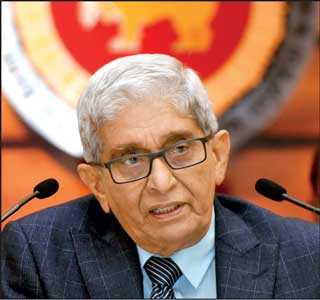Monday Apr 07, 2025
Monday Apr 07, 2025
Wednesday, 20 January 2021 00:00 - - {{hitsCtrl.values.hits}}
By Uditha Jayasinghe
 |
| Central Bank Governor Prof. W. D. Lakshman
|
Joining the effort to propel Sri Lanka to 6% growth in 2021 the Central Bank has decided to keep policy rates unchanged and will introduce priority sector lending targets for Micro, Small and Medium
Enterprises (MSMEs) to propel rapid economic expansion, top officials said yesterday.
Taking advantage of the steep decline in interest rates engineered by five policy rate changes in 2020 and other measures, the Central Bank said it was confident Sri Lanka would reach 6% growth in 2021. This is slightly above the 5.5% outlined in Budget 2021 and significantly higher than the 3.3% projected by the World Bank.
“The turnaround in sovereign yields as well as the notable upturn in the stock market displays confidence that local and foreign investors have placed on the Sri Lankan economy and its prospects. We expect the Sri Lankan economy, particularly the production side, to respond favourably to the fiscal and monetary stimuli in place and also to the novel working environments created by the pandemic,” Central Bank Governor Prof. W.D. Lakshman told reporters during the first monetary policy announcement for the year.
“This progress towards growth has already begun and we have seen several examples recently of domestic industries and other activities taking place. With these and reflecting the pandemic driven contraction in 2020 we expect the Sri Lankan economy to strongly rebound with a growth of around 5%-6%. Improvements on the domestic front will help the Sri Lankan economy stand on its own and also address stability concerns that are being highlighted from time to time in a substantial manner.”
Giving an “exceeded expectations” evaluation to economic performance in 2020 Prof. Lakshman said that despite COVID-19 challenges Sri Lanka was able to reduce the trade deficit by nearly $ 2 billion, keep rupee depreciation to 2.6%, meet debt obligations of $ 4.5 billion and maintain inflation between 4%-6%, a feat it is confident of repeating in 2021. Worker remittances also reached a historic high of $ 813 million in December pushing the annual total beyond $7.1 billion, which is a year-on-year growth of 5.8%.
The Governor’s comments were reiterated by Central Bank Economic Research Director Chandranath Amarasekara, who projected Sri Lanka’s growth would reach 6% this year.
Overall policy rate changes last year reduced interest rates by a total of 250 bps in addition to 100 bps in 2019 while the Statutory Reserve Ratio (SRR) was reduced by 300 bps on two occasions as well. The bank rate was also reduced by 650 bps during 2020.
Reflecting the transmission of monetary policy easing measures, market interest rates continued to decline notably during 2020 and most were at single digit levels. According to Central Bank data, the Average Weighted Lending Rate (AWLR) reduced 304bps from end 2019 to 10.55% while the Average Weighted New Lending Rate (AWNLR) has dipped 409 bps to 8.71%.
Driven by domestic credit, money supply growth accelerated during the latter part of 2020 with Broad Money (M2b) growth expanding from a low of Rs. 7 billion in December 2019 to Rs. 22.3 billion in November 2020. Credit to the private sector also grew 6.2% to Rs. 299 billion by November. Despite COVID-19 impact private sector credit did better last year than 2019 when it only reached Rs. 230 billion.
“Credit to all sectors of the economy is expected to gather pace in 2021 supported by the continued decline in lending rates, implementation of special loan schemes at low interest rates along with the rising demand for credit, driven by improved investor sentiment and the envisaged revival in domestic economic activity.”
Despite the market decrease, interest on loans to MSMEs are typically higher, especially for lower amounts. Data showed that MSMEs typically have to pay an interest rate of 9.69% for loans of Rs. 100,000 or below and 10.48% for loans from Rs. 100,000 to Rs. 1 million, even though AWNLR was 8.71%. Only loans of Rs. 10 million or above typically favoured by larger SMEs were a low 8.57%.
“In support of the envisaged economic revival, the Monetary Board underscored the need to promote the MSME sector, which is the mainstay of the economy. Thus, the Board decided to introduce priority sector lending targets for the MSME sector in consultation with the banking community,” the monetary policy statement said.
By comparison deposit rates have declined much slower with the Average Weighted Deposit Rate (AWDR) reducing by 240 bps to 5.8% while the Average Weighted New Deposit Rate (AWNDR) has dropped 393 bps to 4.96%.
“Most market interest rates have declined to single digit levels, while some have reached their historic lows. Although deposit rates are not expected to decline further, the high level of excess liquidity in the domestic money market leaves sufficient space for market lending rates to adjust downward, thereby providing low cost funds to the economy.”
